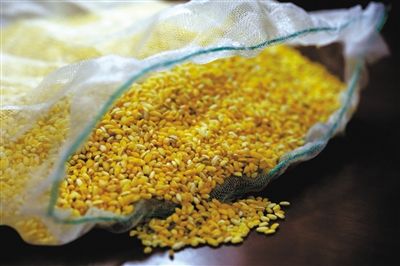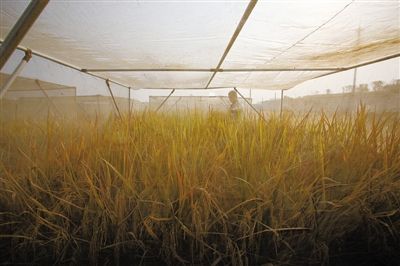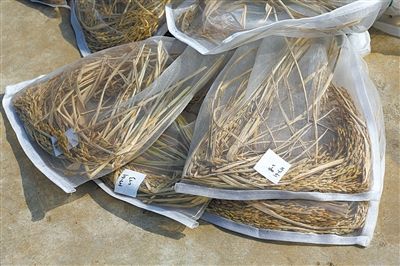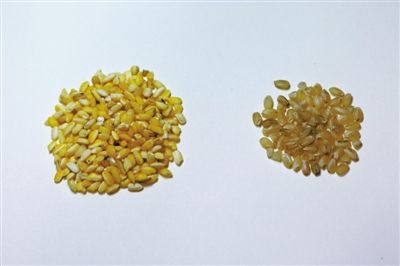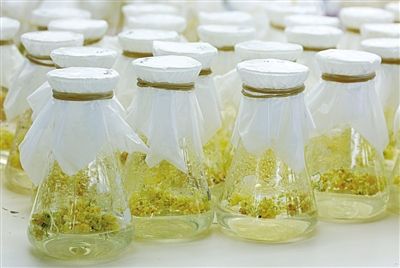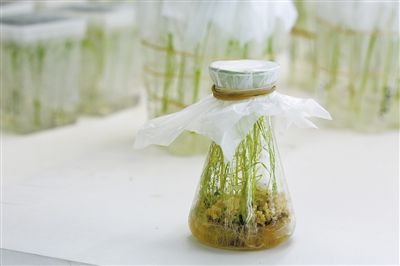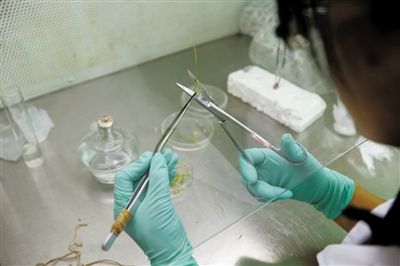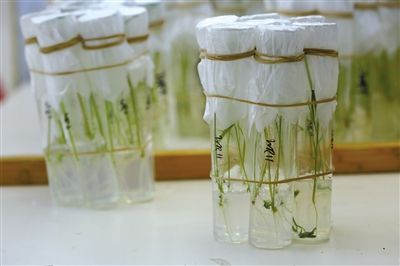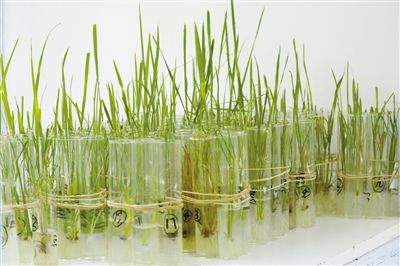The Huanong version of gold rice harvested this year. On October 25th, the researchers looked at experimental plots of transgenic rice that were resistant to migrating pests. To prevent migrating pests from affecting surrounding crops, the transgenic rice was covered with gauze. The selected seeds were dried in the experimental field and artificial breeding was the oldest domesticated crop method. The GM rice experimental field is separated from the outside by a natural lake of 60 mu in order to prevent the occurrence of pollen drift. Huanong version of gold rice and ordinary rice contrast map. Insect-resistant transgenic rice laboratory cultivation process 1 Calli were first induced from non-transgenic rice seeds. 2 Seedlings of insect-resistant transgenic rice are growing in callus. 3 Transgenic seedlings growing in callus. 4 An experimenter isolated the insect-resistant transgenic rice seedlings. 5 Transgenic seedlings that have just been isolated from callus. 6 Seedlings will be sent to Hainan Experimental Shimoda after a long period of time in the culture room. On October 19th, the nation’s first gold rice tasting session was held at Huazhong Agricultural University. Academician Zhang Qifa, dean of the College of Life Science and Technology, said at the tasting meeting: “The decision to industrialize GM rice should not be subject to public opinion but should be followed. Laws and procedures to go, I believe that the decision of the scientific community, the competent authorities do not make a decision, leading to missed opportunities for the industrialization of genetically modified rice, and further delay will be misguided.†Academician Zhang Xu’s comments once again caused the industry to discuss the genetically modified food. There are supporters and there are opponents. The focus of attention is whether GM foods are safe or unsafe. data Transgenic technology was born in 1971. At least 35 families and 200 varieties of transgenic plants have been successfully obtained worldwide. Most people only know the transgenic research of rice, corn, soybeans, and other crops. In fact, blue roses, multi-color morning glory, insect-resistant cotton, and storage-resistant “hundred†fresh tomatoes are all products of transgenic technology. The first generation of golden rice was launched in 2000. In 2005, Syngenta, an American biotechnology company, significantly increased the content of carotenoids in golden rice and gave up all related patent rights, which was provided to developing countries free of charge. Huazhong Agricultural University conducted a gold rice experiment with reference to Syngenta’s technical literature. October 24th in Wuhan is cool and pleasant. The sycamore of Huazhong Agricultural University campus is still lush. The campus forest plant genetic improvement team once cultivated a batch of hairless plane trees, and the problem of spring plane fly flocks was solved by genetic engineering technology. At the southern tip of the school is a large field of experimentation. The golden rice of unreceived GM rice is harvested. A part of the full-grown rice ear is selected as a seed and dried in the ground. Although rice is a self-pollination plant, in order to prevent the occurrence of pollen drift with a low probability, the GM rice experimental field has built a high wall, while the side is nearly 60 acres of the lake, in order to ensure complete isolation of the experimental field and the external environment. At the beginning of October, a dozen of golden rice were harvested here, leaving more than two catties for the laboratory, the superiors and the tasting party. There are only clusters of rice bran and scattered grains of broken rice in the golden rice field. Researchers here have to slap their underwear every time they leave the field and avoid inadvertently taking out seeds. Professor Chen Hao, the person in charge of the Golden Rice Project, said that according to the regulatory requirements for experiments with GM crops, all materials, including rice straw, are not allowed to be shipped outside the scope of the experiment and can only be destroyed by local ignition. Professor Yan Jianbing of Huazhong Nongda University explained that such stringent experimental requirements do not indicate any unpredictable risks for genetically modified crops. They are simply experimental procedures and are not necessarily scientifically necessary. The Chinese gold rice research began in 2011 and is a conventional breeding experiment of Huazhong Nongda. In 2012, the "Human Experiment" of Hunan golden rice children set off a frenzy of public opinion. Afterwards, the media and officials clarified that this was an experiment of human body absorption and transformation instead of safety experiment. However, people's suspicion and panic of GM technology have continued. Chen Hao, head of the gold rice project, said that the golden rice technology has matured and does not involve commercial promotion at this stage. The experiment of the Huanong version of golden rice has not been affected by this incident. Chen Hao said that golden rice only improved its nutritional traits through the transfer of two genes in the carotene synthesis pathway. The taste, planting methods and other aspects are no different from ordinary rice, so it is said that golden rice pollutes the environment and affects fertility completely. There is no reason. Regarding why the United States does not plant golden rice, Chen Hao explained that rice is not a staple food for the Americans. The area of ​​rice planted in the United States is very small, and vitamin A deficiency mainly exists in developing countries in Asia and Africa. The Philippines or will Planting will be promoted next year. Chen Hao is not optimistic about the prospect of gold rice being promoted in China, because insect-resistant genetically modified rice made in the same laboratory has been granted safety certificates for four years and has not been approved for various reasons. Lin Yongjun is 50 years old this year and is the person in charge of the National Major Science and Technology Project, "Planting New Varieties of Insect-Resistant Genetically Modified Rice." He studied 16 years of insect-resistant transgenic rice and ate 14 years of genetically modified rice. In 1999, the anti-insect transgenic rice of Huazhong Nongda passed the results appraisal organized by the Ministry of Agriculture. Subsequent environmental release and productivity experiments showed that the rice had good resistance to aphids and other pests, which increased rice yield by 8% and pesticide application by more than 80%. In 2009, the Ministry of Agriculture issued a safety certificate for the production and application of genetically modified organisms. In 2014, the security certificate line will expire. Lin Yongjun felt distressed. Fourteen years ago, he felt that insect-resistant rice could be promoted and planted. He did not expect to realize it today. And China’s agriculture suffers hundreds of millions of losses every year due to pests. According to Professor Lin Yongjun, conventional breeding has failed to achieve breakthroughs in crop yields and quality, and GM technology will open the door to the second green revolution. Beijing News reporter Huang Yue photography report
Tempered Glass is a heat toughened safety glass. It has undergone a special heat treatment to increase its strength and resistance to impact. Actually, large tempered glass is approximately five times more resistant than normal glass. As example, one piece of 8mm Toughened Glass will be able to withstand a steel ball weighing 500gr dropped from a height of 2 meters.
Tempered Glass Tempered Glass,Glass Shower Doors,Tempered Glass Windows,Glass Balustrade Stairs Jinan Coton Glass Co., Ltd , https://www.cotonglass.com